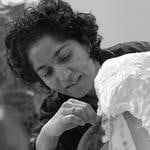

Huma Bhabha (b. 1962) is an artist and sculptor from Pakistan currently based in Poughkeepsie, New York. Trained in two-dimensional media, she is probably best known for her complex sculptures often include a variety of elements ranging from construction materials to found objects, and depict uncanny, human-like figures. Her work also includes drawings, photographs and prints. Bhabha immigrated to the United States in the 1980’s to attend art school. She earned a BFA from the Rhode Island School of Design in 1985 and an MFA from Columbia University in 1989. While originally studying painting and printmaking, Bhabha gradually evolved towards assemblage and sculpture. She then abandoned painting completely. “Eventually it grew off the wall and onto the floor.”
She began exhibiting her work in 1993. Her work was shown in various galleries and museums around the world, which include MoMA PS1, the Whitney Museum of American Art, Palais de Tokyo, and the Metropolitan Museum of Art. Some of her pieces are held in the permanent collections of the Saatchi Gallery, Whitney Museum of American Art, Museum of Modern Art, and New York Public Library.
She is the recipient of the 2008 Aldrich Contemporary Art Museum Emerging Artist Award.
She now lives in Poughkeepsie, NY, with her husband, artist Jason Fox.
Bhabha’s work is characterized by a reconfiguration of familiar materials and artistic conventions across media.
Often incorporating different media within one artwork, Bhabha makes transmediality a central component of her artistic vocabulary and deliberately makes her hand visible in all aspects of the construction of a piece. She also believes that the materials she uses bear mystical qualities that she can activate and explore.
Oscillating between figuration and abstraction, Bhabha’s work often hints at recognizable objects incorporated into haunting, unfamiliar settings.
Bhabha sees herself as a rather intuitive artist, and says: “I don’t work in a thematic way. One sculpture leads to the next… People see a political element to the work. It’s not my intention. It’s not didactic or specific. They see more than what I initially had in mind".